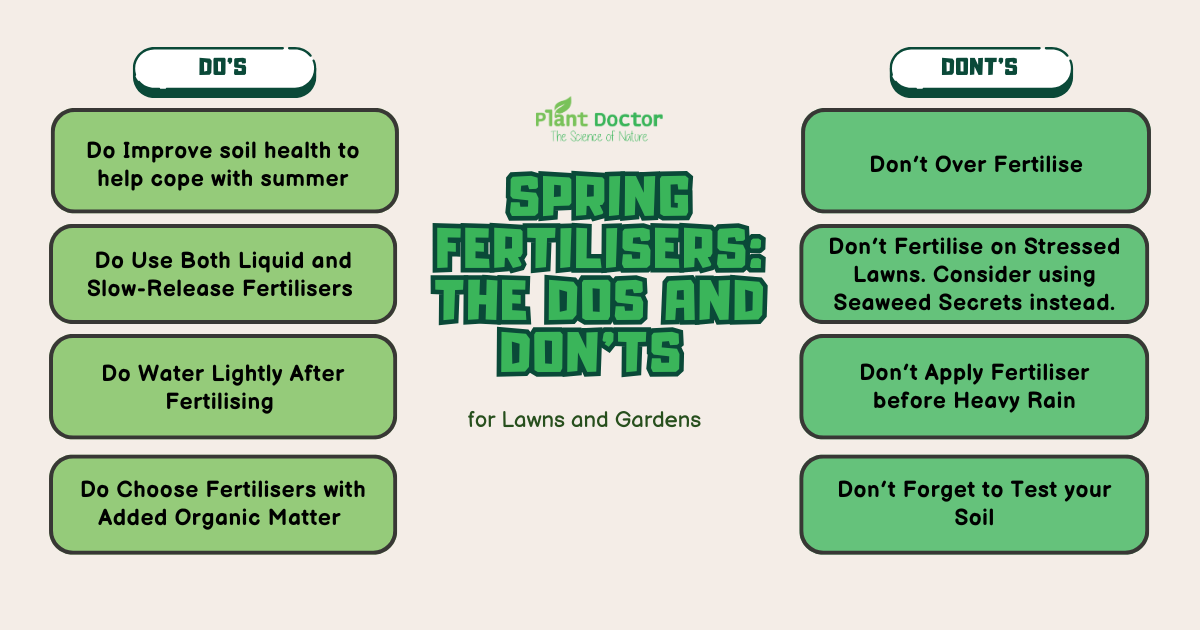Date Posted:21 October 2024

Spring is the season when your lawn and garden wake up from winter dormancy, eager to grow and thrive. To help your plants, flowers, and lawn start the growing season off strong, applying the right fertiliser is essential. However, there are a few important guidelines to follow to ensure that your spring fertilising efforts are as effective as possible. Below, we outline the dos and don’ts of spring fertilising for lawns and gardens.
The Dos of Spring Fertilising
1. Do Fertilise Early in the Season Spring is the perfect time to give your lawn and garden the nutrients they need after a long winter. Fertilising early in the season, typically in mid to late spring when the soil has warmed up, helps jumpstart plant growth and encourages healthy root development.
For lawns, an early spring feed can replenish nutrients lost over winter and give your grass a head start before the heat of summer sets in.
2. Do Use Both Liquid and Slow-Release Fertilisers Slow-release fertilisers provide a steady supply of nutrients to your lawn or garden over time, promoting consistent growth without the risk of overfeeding. These fertilisers are great for preventing nutrient surges that can lead to excessive top growth, making your lawn more vulnerable to disease.
For gardens, using a balanced fertiliser like Activ8Mate ensures that flowers and vegetables get a sustained supply of nutrients, helping them flourish without the risk of nutrient leaching.
3. Do Water Lightly After Fertilising Watering after applying fertiliser helps nutrients absorb into the soil, making them readily available for plant roots. It also helps prevent the fertiliser from burning your lawn or garden.
A product like Nature’s Soil Wetter can further enhance nutrient absorption, ensuring that water and nutrients penetrate deep into the root zone rather than running off the surface.
4. Do Choose Fertilisers with Added Organic Matter Spring is the ideal time to improve your soil’s health as well as its fertility. Organic-based fertilisers, such as those containing seaweed or humic acids like Seaweed Secrets, not only provide essential nutrients but also feed beneficial microbes in the soil. These microbes help break down organic material, improving soil structure and nutrient availability.
Organic matter is particularly important in garden beds, as it improves soil aeration and water retention, creating the perfect environment for healthy root growth.
The Don’ts of Spring Fertilising
1. Don’t Over-Fertilise One of the most common mistakes people make is applying too much fertiliser, thinking more nutrients mean better results. In reality, over-fertilising can lead to nutrient imbalances, burnt grass, and weak, leggy plant growth.
For lawns, avoid heavy doses of nitrogen-rich fertilisers early in spring. Too much nitrogen promotes lush top growth at the expense of root development, leaving your lawn vulnerable to summer drought and stress.
2. Don’t Fertilise on Dormant or Stressed Lawns If your lawn hasn’t fully come out of winter dormancy or is suffering from stress (e.g., due to drought or disease), fertilising can do more harm than good. Fertiliser applied to dormant lawns won't be absorbed efficiently and may cause nutrient buildup in the soil.
For gardens, wait until the soil has warmed up and plants are actively growing before applying fertiliser. Fertilising too early, when plants aren’t ready to absorb nutrients, can be wasteful and ineffective.
3. Don’t Apply Fertiliser Before Heavy Rain Applying fertiliser right before a downpour can cause it to wash away, leading to nutrient runoff that not only wastes product but can also harm the environment. Heavy rain can also cause fertiliser to leach into groundwater, particularly when using synthetic or fast-release products.
Tip: Always check the weather forecast and plan to fertilise when there is no heavy rain predicted for at least 24-48 hours. Light watering or rainfall after application is beneficial, but torrential rain can wash nutrients away before they’ve had a chance to be absorbed.
4. Don’t Forget to Test Your Soil Before fertilising, it’s a good idea to test your soil to understand its nutrient levels. Knowing whether your soil is deficient in nitrogen, phosphorus, or potassium allows you to choose the right fertiliser for your lawn or garden.
A soil test can also reveal the pH of your soil, helping you make adjustments with soil conditioners like Quantum H if needed. Acidic or alkaline soils can prevent plants from absorbing nutrients efficiently, making fertilising efforts less effective.
Conclusion
Fertilising in spring is a key step in preparing your lawn and garden for a successful growing season. By following these simple dos and don’ts, you can ensure that your fertiliser application is timely, effective, and safe for the environment. Whether you're boosting lawn growth or nurturing a vegetable garden, the right fertiliser—applied the right way—will set you up for a lush, vibrant landscape all season long.
With products like Seaweed Secrets, Activ8Mate, and Nature’s Soil Wetter, you can promote healthy, strong growth while improving soil structure and water retention for the best results.
By following these guidelines, you’ll avoid common fertilising pitfalls and give your lawn and garden everything they need to thrive this spring!
First time owning lawn. Gave the team at plant doctor a ring and they supplied me with a wealth of information. Products turned up quickly.
Will definitely be getting more 8 weeks difference been using stimulizer, activ8mate, soil wetter, seaweed secrets and champion fertiliser. Was super fast delivery.
Only have great things to say about Plant Doctor. Organic products and a competitive price, fast shipping and easy to contact with questions. Have had great results with the special mix for lawns, and my plants (indoor and outdoor) love the seaweed secrets. I am excited to test out some of the animal products soon!